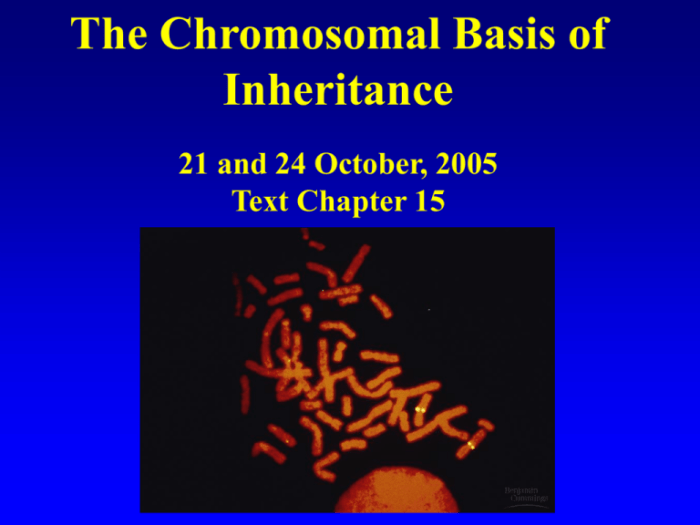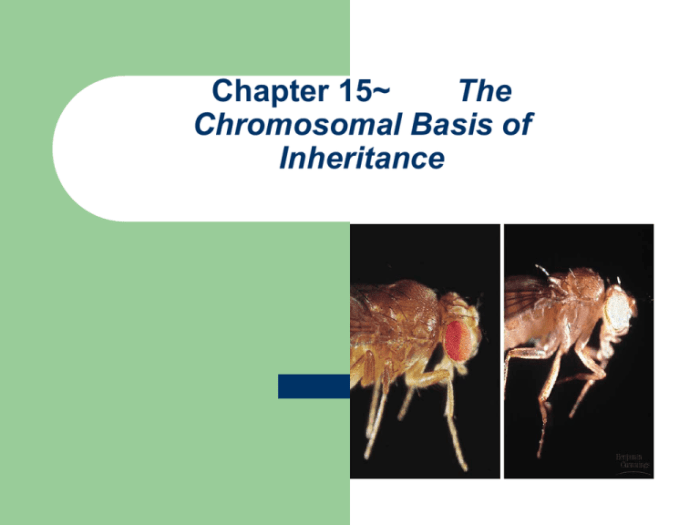Chapter 15 the chromosomal basis of inheritance – Embark on a captivating journey into Chapter 15: The Chromosomal Basis of Inheritance, where the intricate relationship between chromosomes and heredity unravels. This chapter unveils the secrets of gene loci, alleles, and the profound influence they exert on the inheritance of traits.
Prepare to delve into the fascinating world of Mendelian inheritance, exploring the principles that govern the transmission of genetic material. Discover the significance of dominant and recessive alleles, and witness the patterns they create in inheritance. Extend your understanding beyond Mendelian principles, uncovering the complexities of incomplete dominance, codominance, multiple alleles, and polygenic inheritance.
Chromosomes and Inheritance

Chromosomes are structures within cells that carry genetic information. They are made up of DNA and proteins, and they are responsible for determining the traits of an organism. Each chromosome contains multiple genes, which are specific regions of DNA that code for particular proteins.
The location of a gene on a chromosome is called its locus. Different forms of a gene are called alleles.
Gene Loci and Alleles
Each gene has a specific locus on a chromosome. Alleles are different forms of a gene that occupy the same locus. For example, the gene for eye color may have two alleles, one for brown eyes and one for blue eyes.
An organism can have two identical alleles for a gene (homozygous) or two different alleles (heterozygous).
Relationship between Genes and Chromosomes
Genes are located on chromosomes, and the inheritance of chromosomes determines the inheritance of genes. When chromosomes are passed from parents to offspring, the genes on those chromosomes are also passed on. This means that the traits determined by those genes are also passed on.
Mendelian Inheritance

Mendelian inheritance is a set of principles that describe how traits are passed from parents to offspring. These principles were first proposed by Gregor Mendel in the 19th century, and they are still used today to understand the inheritance of traits.
Mendel’s Laws of Inheritance
Mendel’s laws of inheritance are as follows:
- The law of segregation: Each parent contributes one allele for each gene to their offspring.
- The law of independent assortment: The alleles for different genes are inherited independently of each other.
Dominant and Recessive Alleles
When two different alleles are present in an organism, one allele may be dominant and the other recessive. A dominant allele is an allele that is expressed in the phenotype of an organism, even if the organism is heterozygous for the gene.
A recessive allele is an allele that is only expressed in the phenotype of an organism if the organism is homozygous for the gene.
Examples of Mendelian Inheritance Patterns
Mendelian inheritance patterns can be used to predict the probability of inheriting a particular trait. For example, if a parent is heterozygous for a gene, there is a 50% chance that they will pass on the dominant allele and a 50% chance that they will pass on the recessive allele.
Extensions of Mendelian Inheritance: Chapter 15 The Chromosomal Basis Of Inheritance

Mendelian inheritance is a simple model that can be used to understand the inheritance of many traits. However, there are some exceptions to Mendelian inheritance, such as incomplete dominance, codominance, multiple alleles, and polygenic inheritance.
Incomplete Dominance and Codominance, Chapter 15 the chromosomal basis of inheritance
Incomplete dominance is a type of inheritance in which neither allele is dominant. Instead, the heterozygous genotype has a phenotype that is intermediate between the phenotypes of the homozygous genotypes. Codominance is a type of inheritance in which both alleles are expressed in the phenotype of the heterozygous genotype.
Multiple Alleles
Some genes have more than two alleles. For example, the gene for blood type has three alleles: A, B, and O. This means that there are six possible genotypes for blood type: AA, AO, BB, BO, AB, and OO.
Polygenic Inheritance
Polygenic inheritance is a type of inheritance in which a trait is determined by the interaction of multiple genes. For example, skin color is determined by the interaction of several genes.
Chromosome Mapping
Chromosome mapping is a process of determining the location of genes on chromosomes. This process is important for understanding the inheritance of traits and for diagnosing genetic disorders.
Genetic Markers and Linkage Analysis
Genetic markers are DNA sequences that are located at known locations on chromosomes. Linkage analysis is a technique that is used to determine the distance between two genetic markers. This information can be used to create a chromosome map.
Importance of Chromosome Mapping
Chromosome mapping is an important tool for genetic research. It can be used to identify the genes that are responsible for genetic disorders, and it can also be used to develop new treatments for these disorders.
Human Chromosomes
Humans have 23 pairs of chromosomes. These chromosomes are organized into a karyotype, which is a picture of the chromosomes in a cell. The karyotype can be used to identify chromosomal abnormalities, such as Down syndrome.
Chromosomal Abnormalities
Chromosomal abnormalities can be caused by a variety of factors, including errors in cell division and exposure to environmental toxins. Chromosomal abnormalities can lead to a variety of genetic disorders, such as Down syndrome, Turner syndrome, and Klinefelter syndrome.
Detailed FAQs
What are chromosomes and how do they relate to inheritance?
Chromosomes are thread-like structures within cells that carry genetic material in the form of genes. They play a crucial role in inheritance by transmitting genetic information from parents to offspring during cell division.
Explain the concept of gene loci and alleles.
Gene loci are specific locations on chromosomes where genes are found. Alleles are different forms of a gene that can occupy the same gene locus. Each gene locus typically has two alleles, one inherited from each parent.
What is the significance of chromosome mapping?
Chromosome mapping is a technique used to determine the location of specific genes on chromosomes. It involves the use of genetic markers and linkage analysis to construct detailed maps that guide genetic research and the identification of genetic disorders.